On the Garub plains in south-western Namibia, the future of a population of wild horses hangs in the balance . . .
There’s nothing like seeing a wild horse. And, there’s little to compare with seeing a Namib wild horse thundering to the waterhole on the Garub plains, mane flying, dust exploding around its hooves as it gallops in with the wind. The world stills for a brief moment as if life is centring on it - and all else falls away. Eventually time starts moving again, a kelkiewyn calls, a horse whinnies, a breeze blows. The wild horses of the Namib radiate an energy of boundless freedom that touches even the hardest-of-hearts somewhere deep within.
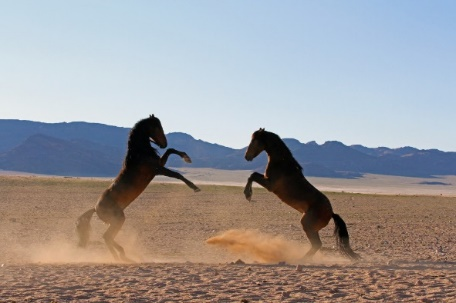
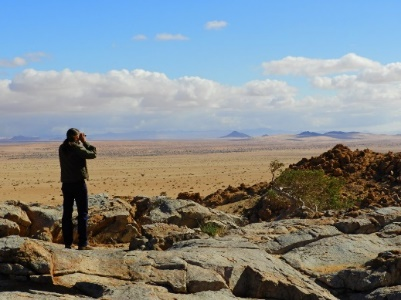
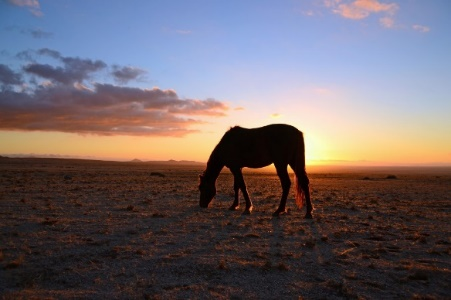
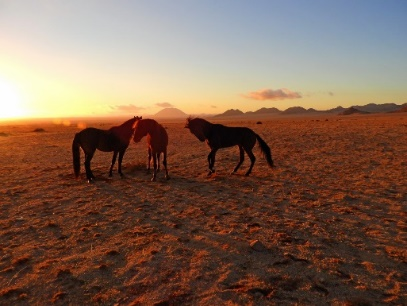
The Wild Horses of the Namib Desert - or Namibs - that live in the Namib Naukluft Park, between Aus and Lüderitz, have been in existence for over a century. Survival in the Namib Desert is no easy feat. Yet, they have adapted their behaviour and endured (with a little help from their friends) the continual cycle of droughts that keep their numbers down and have tempered their gene pool - the cycle of abundance and drought being a natural part of life in the desert. The last few years, however, have brought another challenge that has left them hovering on the brink of extinction. I meet up with wild horse expert Dr Telané Greyling at Garub to hear how they are faring.
I arrive mid-year when the five-year drought has finally broken with 40mm of rain that collects in rock pools and sinks into the thirsty bleached sand. I cannot wish for a more auspicious time for my visit. As we drive along the back roads, Telané stops whenever she sees horses, using binoculars to identify them. We climb out of the vehicle, surveying the surroundings from a clump of granitic rock. “Ah, that’s Richard,” she says. I realise that after almost three decades of studying the horses, she can identify every single horse from the family groups that range from around two to ten individuals, as well as the bachelor stallions. After all, she named them. For her Masters degree in 1994 she studied the behavioural ecology of the wild horses - researching the size of the family groups, group dynamics, what the horses eat and how often they drink - providing fascinating information as to how a population of wild horses lives when not in a domestic setting.

And, as I have learned over the years of becoming acquainted with these wild horses, all the horses on the planet have been domesticated over time. (The only exception is Prezwalski’s Horse - or the Mongolian Wild Horse - that was considered extinct at the end of the twentieth century until a small herd - bred in captivity - was reintroduced into its natural environment.) The domestication of horses began on the Eurasian steppes 5000 to 6000 years ago and spread from there around the world. For the subsequent 4000 years, horses have been in service to humankind. The wild horse populations today that are found in small pockets on virtually every continent of the world have escaped their domestic constraints, which is probably why they pull on our heartstrings and lift our spirits. Remembering their roots from the time when Equus caballus ran wild and free on Earth belonging only to themselves, the horses resumed their natural way of life forming family groups and living off the land - as if the millennia of domestication was just a dream.
Telané monitored the horses over the years, doing an environmental assessment on the Namibs between 2003 and 2006, and offering possible management strategies. In this three-year study she ascertained that over the century of their existence (they are now in their tenth generation) the horses found their own niche in the desert’s ecosystem, not displacing or negatively impacting any flora or fauna.
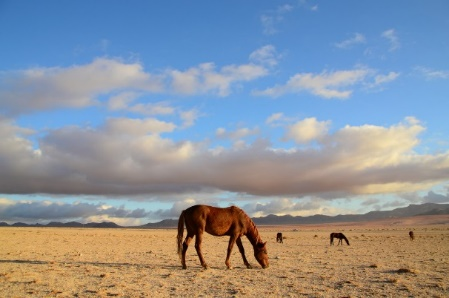

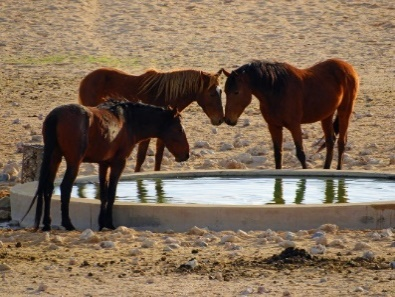
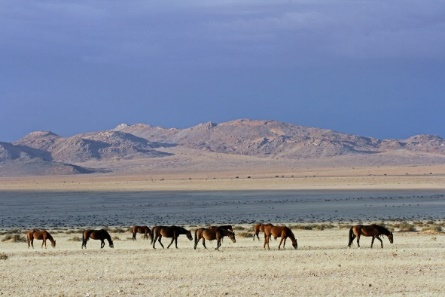
As we drive along, she points out dainty grass stems (difficult to see at a glance), which have emerged after the first shower at the beginning of the year and have enabled the Namibia Wild Horses Foundation to stop feeding the horses. It has been a mammoth operation over the last three years, with the public generously donating both funds and feed. Their efforts would have enabled the population to survive, as it has in other drought years, until the rains arrived. However, the additional factor that threw a spanner in the works this time round was a clan of spotted hyena that moved into the Garub section of the Namib Naukluft Park and started preying predominantly on the horses.

It didn’t take long for the wild horse population to plummet from 286 to 79 horses, with not one foal surviving. “In 2013, they caught and killed a hundred horses, fifty of them foals,” Telané says. This brought various concerned parties together to meet with the Ministry of Environment and Tourism (MET) to look for a solution to safeguard the future of the population, which has become a popular tourist attraction, embodying the rugged, soulful desert and the wide, open spaces of Namibia. With MET adhering to its non-interference policy in national parks, the foundation asked for permission to provide an alternate food source for the hyenas to try and draw their attention away from the horses. This they were granted. They also requested permission to move the horses from the park to ensure their survival, and began investigating renting farmland in the vicinity, subject to custodianship, with the option to purchase when funds could be raised. While everyone waited anxiously for the ministry’s green light, the predation continued, placing the genetic integrity of the population at risk as the number of mares dropped to 33, the lowest in their recorded history.
Leaving the horses and Telané in the south, I drive northwards to Windhoek to meet Manni Goldbeck, who is the chairman of the Namibia Wild Horses Foundation and has spent many years researching the history of the horses. Having grown up on a farm in Namibia, horses are in his blood. He shares his favourite Churchill quote, which aptly describes the virtue of horses: “There’s something about the outside of a horse that is good for the inside of a man."
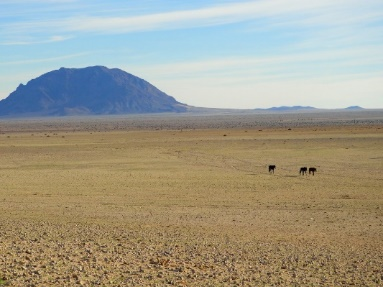

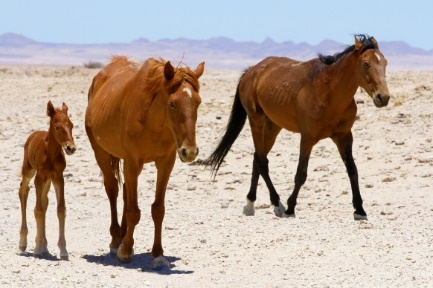
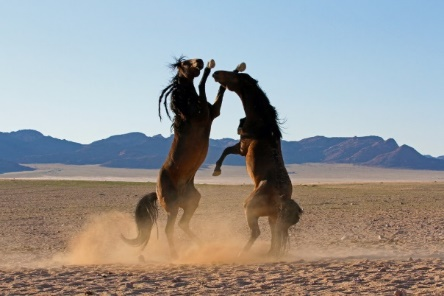
“I have always been fascinated with the Namibs,” he says, “and how they have been able to survive in such a harsh environment for more than a hundred years.” He became aware of them thirty years ago when he entered the tourism industry and started to put itineraries together for tourists. Little was known about their behaviour, however, until Telané began her research. Her knowledge added to his research as a hobby historian. But, the theories that were circulating about the horses’ origins didn’t gel for him. “It wasn’t enough that people said that they came from Duwisib and the shipwreck along the coast, as anyone who knows the desert and distances, knows it is impossible.” He wanted to dig deeper into it and it took almost twenty years to get to the crux of what actually happened.
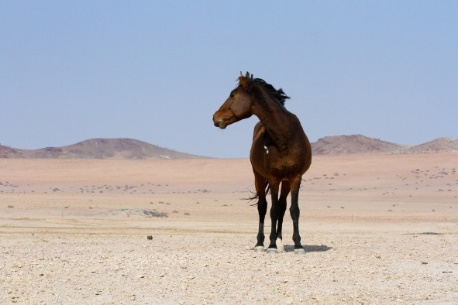
“A friend and fellow hobby-historian, Walter Rusch, discovered a photo album in London while he was doing research on the 1908 diamond rush in Namibia.” When Manni looked at the photos of Emil Kreplin, the mayor of Lüderitz in the early 1900s and one of the early diamond magnates, and those of his stud farm at Kubub, the mystery began to unravel. Kreplin had started the stud farm some distance inland from the coastal town to breed horses for racing and recreation, and mules to work in the diamond fields. The markings and conformation of the horses in the photographs at Kubub bear remarkable similarities to those of the Namibs today. Manni continues to tell me how the tumult of WWI changed the course of history for both man and beast when Lüderitz was occupied by the Union of South Africa troops in 1914. The residents, including Kreplin, were interned for the duration of the war, with many returning to Germany afterwards. “With no-one to look after the stud farm, the horses were on their own and followed the open water and grazing until they reached Garub, 30km away, where a borehole was maintained for the steam trains.” Here they would have met up with any Union horses that remained at Garub (which served briefly as a Union base during the war) after it was bombed by the German troops when they retreated inland with the Union soldiers in hot pursuit. With the country in chaos, other stragglers may have joined the group of horses. Garub was in the forbidden diamond territory - the Sperrgebiet, which provided a certain amount of protection over the years. In the late 1980s, it was incorporated into the Namib Naukluft Park.



I listen carefully to Manni’s words, never tiring of hearing about the rich history of this intriguing population, now recognised as a unique breed, authenticated by DNA analysis and blood-typing. We chat about the present-day issues that are threatening the population, and the possibility of the foundation being granted custodianship of the horses to be able to move them to Kubub or a farm in the vicinity. Manni feels positive: “With the support of all the horse-lovers out there, we can tackle it,” he says. “Horses played such a huge role in the evolution of humankind - and in Namibia; for exploration into new lands and for transport, recreation, war, industry and agriculture, and are integral to the history of humankind. We should honour that.” He tells me: “On a recent Facebook survey, 95 per cent of Namibians from all walks of life felt that we should preserve the wild horses for future generations - and that says something. It is heart-warming. We cannot allow the horses to die.”
I follow the story for the next few months as the May rain turns the Namib to green and a carpet of flowers covers the desert floor. The horses graze and fill out, rapidly picking up condition. And, then, with still no decision forthcoming from the ministry, an unexpected turn takes place. The hyenas venture onto the surrounding farmland, challenging the farmers and leaving the horses in peace and safety for the time being.
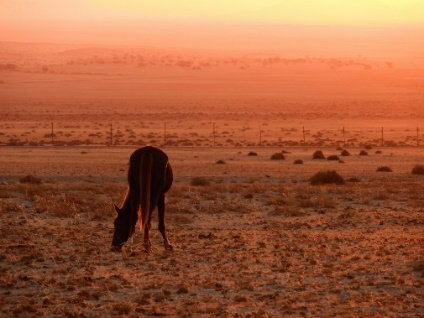
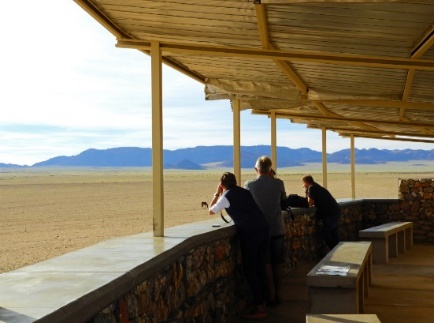

Although the remaining horses are fat, their fate still hangs in the balance. Mares have conceived after the rains and there is a feeling of hope in the air. This brings up many questions: Will these foals be able to survive predation by the hyenas and herald another era of wild horses? Or are these the last of the Wild Horses of the Namib Desert that will grace the planet and that we will have the privilege of getting to know?
On my way south, before I leave Namibia, I make a stop at the Garub hide that looks out on the waterhole and the plains, as I usually do when I pass. I watch the horses gallop to the water, with all the wild beauty and freedom that I feel they have earned. The wind whips up their manes and the sun catches their shining coats. A foal has been born while I have been away. I watch the newborn with wonder and can’t help feeling hopeful.
For more information see www.wild-horses-namibia.com
Follow the Namibs on www.facebook.com/NamibiaWildHorsesFacebook